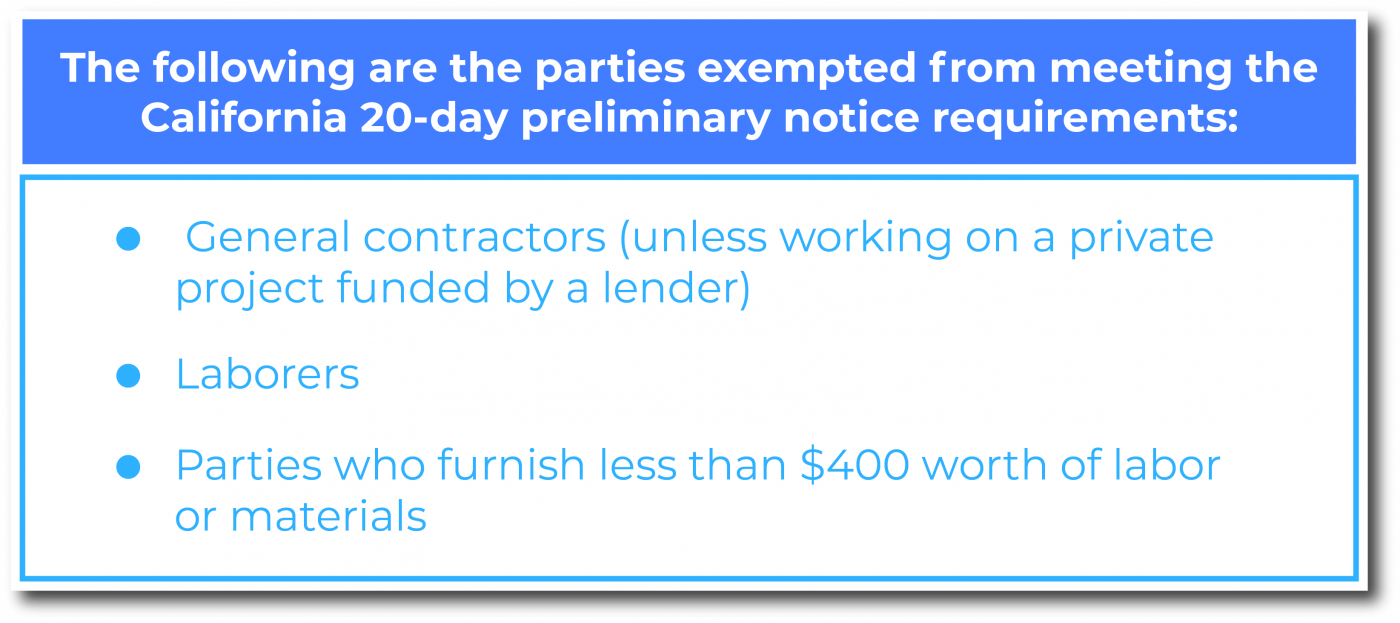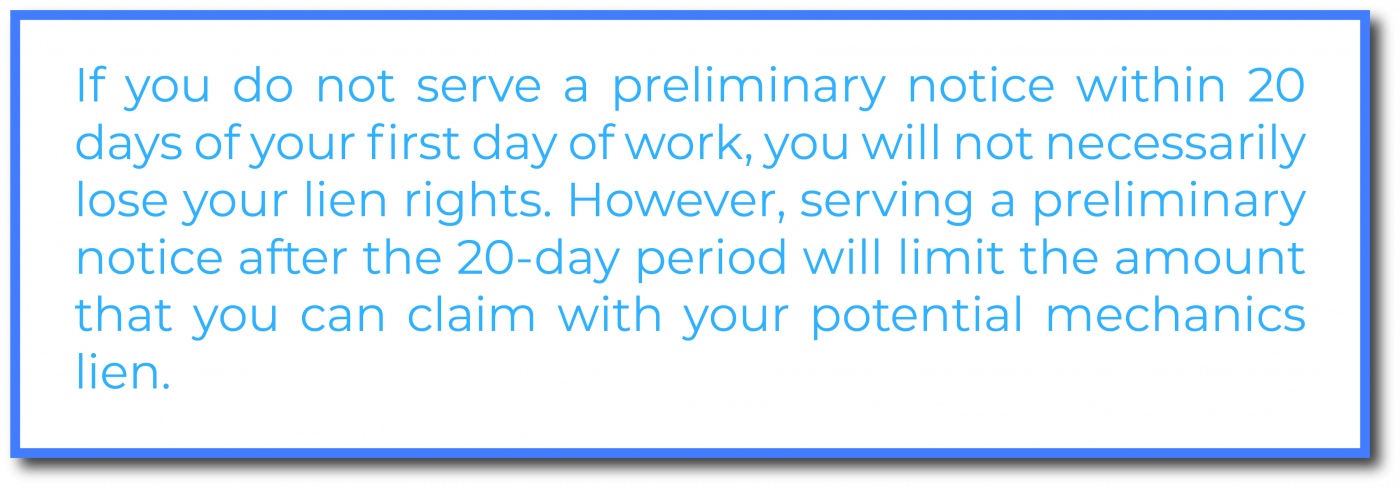

If you are a contractor, subcontractor, or material supplier working in California, you might be wondering what the California preliminary notice requirements are. You may know that you have to serve a preliminary notice, but you may not be quite sure where you can get the information that you need to fulfill the California preliminary notice requirements.
This guide will answer your basic questions about California preliminary notice requirements, from which parties must serve them to what details must be included in the preliminary notice forms and where to find these pieces of information.
In California, the 20-day California preliminary notice requirements apply to the following parties:
For public projects, only second-tier and lower subcontractors and material suppliers are required to serve a preliminary notice. However, all types of contractors and material suppliers must serve a 20-day preliminary notice in California if they are working on private projects.
General contractors are technically only required to send a California 20-day preliminary notice when they are working on a private project that is funded by a lender. For public projects and for private properties that are not being financed through a lender, general contractors in California do not have to serve a 20-day preliminary notice.

As mentioned, general contractors – unless working on a private project financed through a lender – do not have to serve a 20-day preliminary notice in California.
The exemption applies to general contractors because they already have a direct contractual relationship with property owners. The purpose of sending the requirements for 20-day California preliminary notice is to inform property owners that a construction participant is actively involved in a project. This way, owners would know who the parties are who could potentially file a mechanics lien against their property.
Other than general contractors, laborers are also exempted from the California 20-day preliminary notice requirements. Property owners already know who their laborers are so they do not have to send a notification through a 20-day preliminary notice.
Lastly, parties who work for only $400 or less do not have to serve a 20-Day California preliminary notice. Only those whose contracts and agreements are worth over $400 must meet the preliminary notice requirements.
You must include the following information in your 20-day California preliminary notice:
Name of the owner or reputed owner
This is the name of the property owner or the reputed owner; reputed owners could be tenants who initiated the improvement on a property. You may ask the general contractor for the name of the property owners and the lenders; general contractors are obligated by law to provide you with such information.
Name of the contractor director and their address
This is the name and address of the general contractor.
Name of the lender and their address, if any
This is the name of the lender. You must include this part if the project is financed through a lender; otherwise, you may put “N/A.” You ask the property owner for the name of the lender to ensure that you have the correct details.
General statement of the work provided
This is a brief description of the type of services that you provide to the property.
Financial estimate of the price of total work provided
This should be the same as the contract amount or the amount that you agreed to receive for the services that you will be doing. DO NOT add lien-related costs and other miscellaneous fees to the contract amount or you might risk invalidating your potential mechanics lien.
Name and address of the person or entity who provided the work or materials
This is your name and address.
Name and address of the person or entity to whom the work or materials are provided
This is the name and address of the party who hired you. This part could be the same as the name and address of the general contractor if you are working directly under a general contractor. If you are a general contractor, this may be the name of the property owner.
Description of the site for identification, including street address if possible
This is a description of the project site location; a street address will suffice but try to include details (e.g. tax parcel number) that could make the property sufficiently identifiable.
Legal notice statement (in boldface type)
This is the following statement, which you must copy and paste onto your 20-day California preliminary notice exactly as it is written:
NOTICE TO PROPERTY OWNER EVEN THOUGH YOU HAVE PAID YOUR CONTRACTOR IN FULL, if the person or firm that has given you this notice is not paid in full for labor, service, equipment, or material provided or to be provided to your construction project, a lien may be placed on your property. Foreclosure of the lien may lead to loss of all or part of your property. You may wish to protect yourself against this by (1) requiring your contractor to provide a signed release by the person or firm that has given you this notice before making payment to your contractor, or (2) any other method that is appropriate under the circumstances. This notice is required by law to be served by the undersigned as a statement of your legal rights. This notice is not intended to reflect upon the financial condition of the contractor or the person employed by you on the construction project. If you record a notice of cessation or completion of your construction project, you must within 10 days after recording, send a copy of the notice of completion to your contractor and the person or firm that has given you this notice. The notice must be sent by registered or certified mail. Failure to send the notice will extend the deadline to record a claim of lien. You are not required to send the notice if you are a residential homeowner of a dwelling containing four or fewer units.
As the name implies, you must comply with the California 20-day preliminary notice requirements within 20 days of your first day of work. Your first day of work corresponds to the day when you first furnish labor or materials to the property.
There are three valid modes of delivery in order to fulfill the 20-day preliminary notice requirement in California:
1. Delivery in person
2. Delivery via registered or certified mail
3. Delivery using the Handle app
You may leave your 20-day preliminary notice at the place of residence of the property owner or reputed owner. If you do so, make sure that you get the recipient to sign an acknowledgment of receipt so you have proof. It is very important to keep these documented receipts that would verify your compliance with California’s preliminary notice requirements.
You may also mail your 20-day preliminary notice to the last known address of the property owner. You are encouraged to choose the return receipt request option so you can receive a receipt once the 20-day notice has been received.
Service of the notice is complete upon mailing, and a tracking record is enough proof that delivery has been attempted.
You may also use the Handle app to serve your California 20-day preliminary notice. Handle will not only make sure that your preliminary notice gets delivered, but also ensure that your California preliminary notice is valid and meets all the requirements.
If you do not serve a preliminary notice within 20 days of your first day of work, you will not necessarily lose your lien rights. However, serving a preliminary notice after the 20-day period will limit the amount that you can claim with your potential mechanics lien.
A preliminary notice in California sent late only covers work done during the 20 days prior to the date when you serve the notice up to the end of the project. If, for example, you start work on August 1 and you serve a preliminary notice on August 30, your potential mechanics lien can only claim the amount that covers the services you provide during the 20 days prior to August 30 and until your work is done. The work that you do before that period will not be claimable with a mechanics lien.

Note that even if you miss the 20-day preliminary notice deadline, you must still serve one in order to meet California’s notice requirements. You need a valid preliminary notice served on the property owners as well as the lender, if applicable, before you can file a mechanics lien.
Lastly, failing to serve a valid preliminary notice may subject you to disciplinary actions under the Contractors State License Board. You may be liable for up to $5000 worth of fines if you fail to meet the 20-day California preliminary notice requirement, so make sure that you do your best to fulfill this requirement properly and on time.